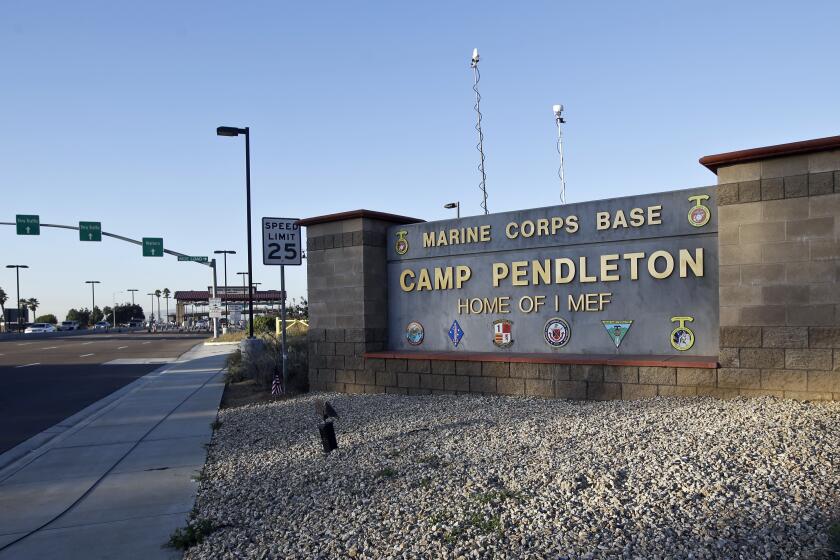Supreme Court to hear 1985 murder case
It’s been 25 years since Hector Ayala was sentenced to death in the execution-style murders of three men. The victims, with hands bound behind their backs, had been shot in the head in an auto repair shop off 43rd Street in southeastern San Diego.
But an issue over whether blacks and Hispanics were unfairly kept from sitting on the jury has continued to languish in the appeals process, and is now being revived by the U.S. Supreme Court.
Justices on Monday granted review of the case and will likely hear arguments in March.
California Attorney General Kamala Harris petitioned the high court for review in May, after the U.S. 9th Circuit Court of Appeal reversed Ayala’s conviction in 2012. Despite the ruling, Ayala, 63, has remained in segregation at San Quentin State Prison until all appeals are exhausted.
The killings occurred April 26, 1985. The lone survivor, Pedro Castillo Jr., gave a harrowing account of the terror at A & Z Auto Repair that night.
Ayala and his brother, Ronaldo Ayala, arrived at the garage with a third man around noon and stayed through the evening, drinking. Hours later, Castillo walked in on what appeared to be a robbery.
The three victims — owner Ernesto Mendez Dominguez, 30; his former brother-in-law Marco Zamora-Villa, 31; and employee Jose Rositas, 24 — had their hands duct-taped behind them while the Ayalas and the third man trained guns on them. The demand: hand over $10,000 or someone would die, according to courtroom testimony. Castillo later admitted to knowing that drugs were sometimes sold out of the shop.
Castillo, his hands also bound, was able to run out of the garage door, and a spray of bullets followed.
Two San Diego police officers saw him staggering down 43rd Street. He’d been shot in his right side and also stabbed.
The other three victims were found dead with gunshots to the head.
Hector Ayala’s trial kicked off in 1989 with three months of jury selection. His brother, tried separately, had already been sentenced to the gas chamber by then.
Out of a pool of 200 potential jurors, the lawyers were allowed 20 pre-emptory challenges each. Of the 18 that prosecutors used, seven targeted black or Hispanic jurors.
The defense lawyers raised several objections at the time, and when Superior Court Judge Napoleon Jones asked one of the prosecutors to explain himself, he agreed but wanted to do it in private so as not to reveal his legal strategy to the defense. The judge agreed despite the defense’s objection and, after hearing the reasons in private, ruled that the challenges weren’t made because of race.
The prosecutor gave the following reasons for dismissing the seven potential jurors:
• One opposed the death penalty.
• Another had several past run-ins with law enforcement and showed a paranoia of the criminal justice system.
• A woman answered jury questioning very slowly and might have been on drugs.
• A man had difficulty reading, writing and speaking English and couldn’t express his opinion on the death penalty.
• One man said he was the sole holdout in a previous jury, and had a history of being rejected for a job as a police officer.
• One said he’d asked around his neighborhood about Ayala.
• A man who was initially kept on the panel but ultimately booted had said he was unsure if he could actually impose a death sentence on someone even though he generally supported the measure.
The final jury seated to hear the two-month trial was devoid of any black and Hispanic members. They convicted Ayala, who is Hispanic, of three counts of murder, one count of attempted murder and three counts of attempted robbery, as well as two special circumstances. He was sentenced to the gas chamber in 1989.
It wasn’t his first time in prison. Ayala had served time for armed robbery, burglary and possession of heroin, and had stabbed one inmate and killed another while he was imprisoned on those charges, a prosecutor said at the time.
Ayala’s habeas corpus appeal hit the state Supreme Court in 2002, repeating many of the same objections brought up at trial. A divided panel of the court ruled that the trial judge had in fact erred by allowing the prosecutor to secretly justify the dismissals. But the panel also found that the error ultimately caused no harm to the case, and the conviction would stand.
A divided panel of the 9th Circuit took another stance, and reversed the conviction.
The federal appeals court ruled that Ayala was deprived of being able to present and likely prevail on a claim of biased jury selection, calling some of the prosecutor’s reasons for dismissals “highly improbable.”
The “statistical evidence alone raises some debate as to whether the prosecution acted with a race-based reason when striking prospective jurors,” the 9th Circuit opinion states.
The panel added that an advocate should have been able to assist the judge in pointing out potential deficiencies in the prosecutor’s arguments, and further ruled that the trial court erred by losing nearly all of the juror questionnaires.
When the case goes before the U.S. Supreme Court, the jury selection issue will only be an underlying current. The lawyers will instead be arguing the case on a narrow point of law: to what extent the 9th Circuit must give deference to the state Supreme Court’s conclusion when an error is found, and if there’s a difference whether the error was determined to be harmless or not.
“It is an important constitutional issue the Supreme Court is going to decide and my hope is they recognize the 9th Circuit was correct,” said Ayala’s appointed appellate attorney, Anthony Dain.
If the Supreme Court sides with Ayala, the District Attorney’s Office would have the option to retry him.
He added that Ayala and his brother maintain their innocence. The third suspected accomplice, Joseph Moreno, was later acquitted by a jury of all charges. Jurors said there was no evidence to show he did anything other than follow orders.

